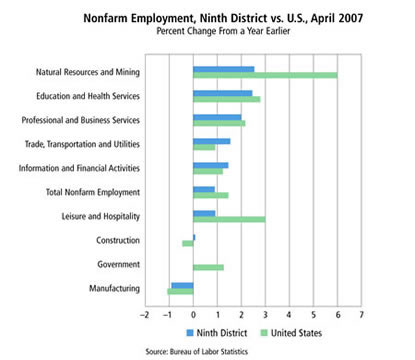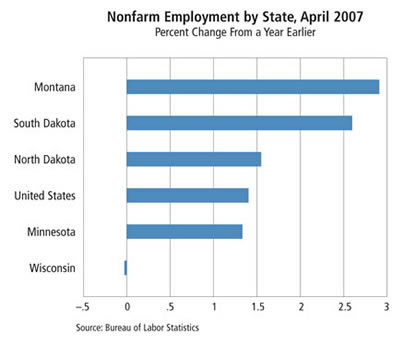While overall economic growth in the district is expected to increase moderately through the remainder of 2007 and 2008, activity in the district's western states has been pulling ahead of growth in its eastern states. For example, Montana's unemployment rate was the lowest in the nation in April at 2.2 percent, while unemployment rates in Minnesota and Wisconsin increased over the past six months.
Districtwide, solid activity in the natural resources, professional and business services, and manufacturing industries has more than made up for slowness in home building. Meanwhile, retail sales continued to expand despite higher gas prices during late spring. District farmers recorded early spring plantings and above-average crop progress. Relatively strong commodity prices are forecast for 2007 and 2008.

Employment growth stronger in the west
Nonfarm employment growth was higher and unemployment rates lower in Montana, North Dakota and South Dakota compared with Minnesota and Wisconsin, as well as with the national average.
District employment growth in April posted the strongest gains in natural resources and mining (2.6 percent), education and health services (2.4 percent), and professional and business services (2 percent). Montana and North Dakota had particularly strong gains in natural resources and mining. Sectors with flat employment levels included construction and government, while the manufacturing sector decreased 0.9 percent. However, Montana showed strong gains in construction employment (11 percent), and South Dakota increased manufacturing jobs by 4.1 percent.
The Minneapolis Fed's forecasting models predict that during the rest of 2007 and 2008, employment growth will remain stronger in the western states compared with the eastern states (see forecast).
Over the past year, unemployment rates in Montana and the Dakotas remained relatively low. Unemployment rates in Montana dove as low as 2 percent in March. Meanwhile, over the past six months unemployment rates drifted higher in Minnesota and Wisconsin. As with employment growth, the forecast for unemployment rates in 2007 and 2008 is more optimistic for the western states than the eastern states.

Housing sector slows growth
During the first quarter of 2007, U.S. gross domestic product increased only 0.6 percent at an annualized rate, the slowest quarter of growth since the fourth quarter of 2002. A primary culprit for the slow growth was the housing sector, which pulled down the growth rate by almost a full percentage point.
In district states, housing units authorized were down 30 percent for the three-month period ended in April compared with a year earlier. However, the decrease was concentrated in the eastern states, as Montana and North Dakota were up 16 percent and 9 percent, respectively. First quarter sales of existing homes were down 9 percent in Minnesota and 7 percent in Wisconsin, were flat in Montana and South Dakota and increased 5 percent in North Dakota. Looking forward, the forecasting models generally expect housing units authorized to decrease in most states during 2008.
However, other sectors have partially offset slow home building. Natural resource industries continued to grow, particularly oil drilling and mining in the western part of the district. The number of active oil rigs in Montana and North Dakota increased to 54 in May 2007, up from 51 in May 2006 and 34 in May 2004. The Minneapolis Fed's survey of professional services indicated expansion in the sector over the next 12 months, including gains in sales revenue, profits and productivity. While manufacturing employment levels were lower in April compared with a year earlier, a May survey of purchasing managers by Creighton University showed solid growth in manufacturing activity in Minnesota and the Dakotas.
Retail sales remain solid despite higher gas prices
Gasoline process in the first week of June were about 40 cents per gallon higher than a year earlier in Midwest and Rocky Mountain states and were above $3 per gallon in many parts of the district since the beginning of May. Combined with the slow housing sector, higher gas prices could have dampened retail sales. Nevertheless, the International Council of Shopping Centers reported that U.S. same-store sales rose 2.5 percent in May compared to a year ago. Relatively low unemployment rates and rising personal income have helped retail sales remain solid.
Fortunately, the run-up in gas prices hasn't been accompanied by significant increases in consumer prices generally. The core inflation rate—the increase in consumer price index not including volatile food and energy sectors—was up 2.3 percent in April compared to a year ago. When accounting for food and energy, the CPI will likely grow faster than the core inflation rate at least during the summer months, when gasoline prices are expected to remain above $3 per gallon, according to a June short-term outlook report issued by Energy Information.






